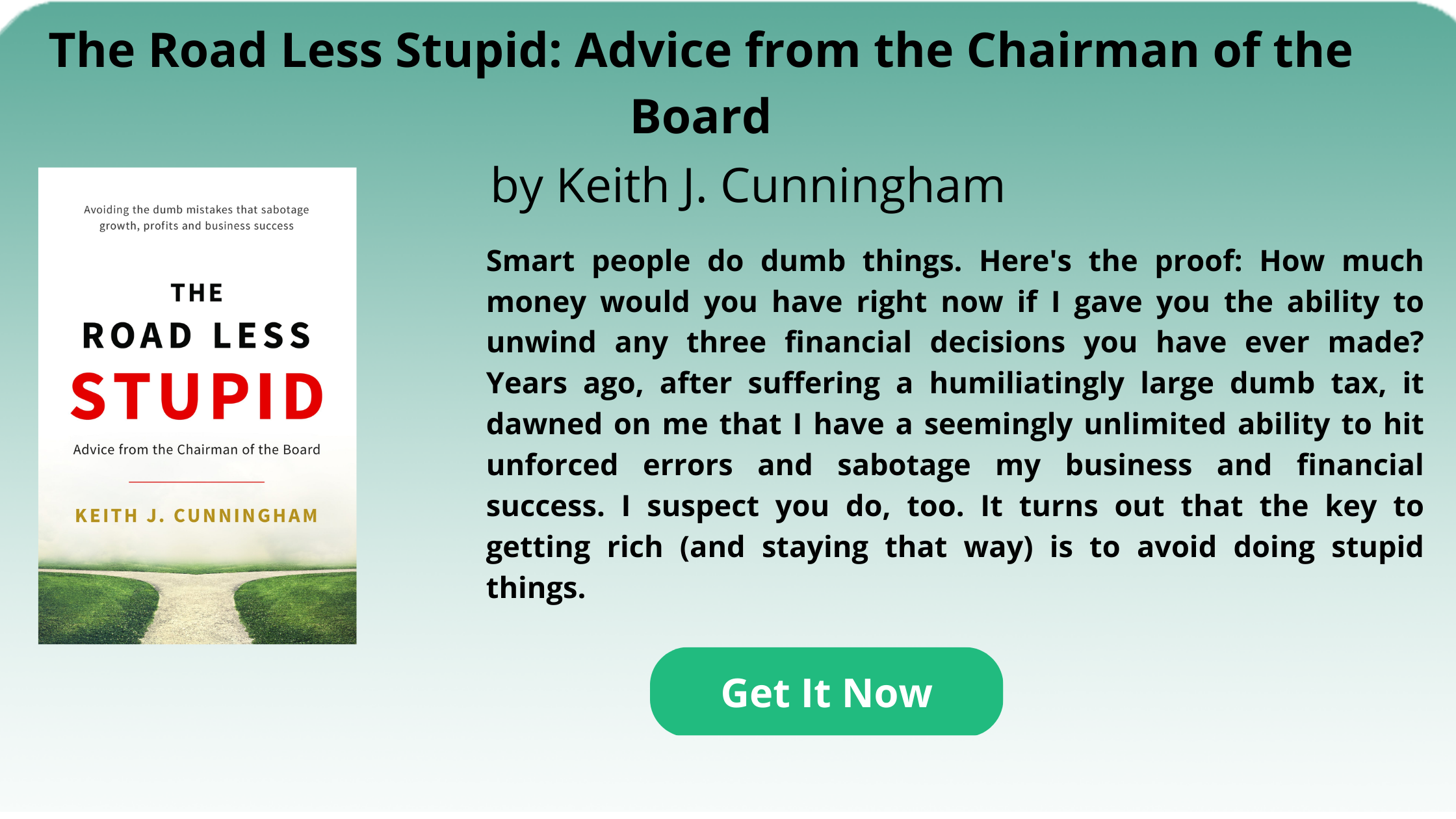When discussing business exit planning, there are some interesting statistics: 100% of business owners will leave their businesses, whether planned or otherwise; 79% pf business owners plan to exit their businesses in the next 10 years or less; 80% of owners believe that a successful exit will result from planning and action items they implement. But here is the catch – only 17% of owners have created a written plan… and often it takes 3 to 5 years to develop one (Source: Business Enterprise Institute). Those statistics are a little aged, but I bet it isn’t that far off now.
In my experience with discussing exit planning with business owners, it is a subject that they very often want to put off until they finally wake up one day and they don’t want to work in the business anymore, and decide they’re going to sell it. But the reality is, they usually are nowhere near to where they need to be in properly preparing the company for a successful sale, for many reasons. Because of that, the business often isn’t worth what they think it’s worth. Furthermore, they haven’t structured things to make their exit as tax-efficient as possible, often incurring avoidable taxes. In order to address those realities, it takes time, often 3 to 5 years to accomplish.
But one way or another, the owner will exit their business, and most of these ways aren’t advisable. Here are several ways that a business owner can exit their business, which are the least productive:
“The Wishes Are Horses” Exit Plan – There is the old saying, “if wishes were horses, then beggars would ride.” This is the situation where, if the owner just wishes it to be so, a good exit outcome will occur. If they just wish it and or hope it, a successful exit will happen.
The “Uncle Sam is My Friend” Exit Plan – I see this situation often, especially if the owner goes directly to market using an M&A person or a business broker, without out prior planning. I do not mean to put those advisors in bad light, it is just often over-looked that there are several pre-sale strategies and tactics that we can put into place that can potentially save the business owner millions in taxes on the sale. But Uncle Sam and the State Government will be happy.
The “Put Your Head in the Sand” Exit Plan – This is an exit plan where the business owner puts his or hers “head in the sand” and puts off or ignores addressing disputes or issues which they know may occur or needed to be dealt with on account of their expected or unexpected exit.
The “Let My Surviving Spouse Deal with It” Exit Plan – This is the situation where the owner simply keeps on working without ever attempting to put together an exit plan. And then one day, something happens to them and they are unable to be around to run the business, or God forbid, they die. Spouse is then forced to deal with it or forced to liquidate a business, or sell it at a fire sale price, lose key employees, etc.
The “Mulligan” Exit Plan – This is described in the book, “The Next Move” by Nick Nieman, where in a friendly game of golf, the players can take another attempt at a drive off the tee, if the first one doesn’t work so well. This doesn’t work in professional golf, and it doesn’t work well when exit planning, where if for example, you become disabled or unexpectedly die, without the appropriate strategies and funding in place to deal with your unexpected exit. You or your family don’t have the opportunity to do it over. Another example is that you have just lost your key employee that you thought was going to be your successor, because he or she grew tired of your uncertain future plans, and you don’t get a “Do over.”
The “Wait and See” Exit Plan – As described in the book “The Next Move”, the business owner is forever and forever unwilling to make a decision about how to proceed. The paralysis that results from the owner taking the “let’s wait and see” approach to see how things turn out tomorrow before making a decision can be very detrimental. In practicing the discipline of exit planning and executing the process, gives you the opportunity to operate under the principle that “all plans are firm until changed.” This means that it is generally advantageous to establish a plan and then revise and adjust it as needed depending on what happens tomorrow.
The “Flea Flicker” Exit Plan – In American style football, there is a well-known play called the “flea Flicker” in which the ball is hiked into play and handed off or lateralled to the running back, who then fakes a run and “flicks” it back to the quarterback, who then throws a long pass. This play gives up a more likely chance of a reasonable gain in yardage for a low percentage long pass, that is high-risk that either results in a big gain, a turnover or a loss.
In relation to an owner’s exit plan, the owner gives up a profitable and reasonable exit outcome (by having a solid exit plan), always shooting for the extraordinary outcome with the low percentage occurrence.
The “Incapable Buyer” Exit Plan – With this type of exit plan, because of the lack of pre-selling planning, the owner ends up selling the business to an incapable buyer for an installment note who ultimately defaults on the payments resulting in the business being relinquished by the owner/seller, typically in a dire condition. The owner then attempts to sell it again.
The “Scorched Earth” Exit Plan – This is an exit plan where the business owner or owners decide that they will deplete the business of all of the cash resource potential, leaving a business which is capable of surviving. This is maybe appropriate if the business was destined for liquidation. However, if it works to the detriment of key employees, long employed and dedicated staff and valued customers who have relied on the owner and the business, then in the end, this approach is likely something that the owner will regret.
The “Holding the Bag” Exit Plan – In this exit plan, a dominant owner forces out his or her co-owners on terms that are unfair, resulting in the dominant personality holding entire ownership of the company which in large part has been purchased at a discount. This obviously compromises the position of the co-owners.
The “Canned” Exit Plan – This would be the exit plan which a mis informed consultant has sold them on, which is a cookie cutter exit plan that has failed to tailor the specific objectives of the business owner to the circumstances of the business and the family. A “cookie cutter” approach runs the risk of not considering many important areas that could profoundly affect the owner, and may not be able to be reversed once the business is sold.
The “Deathbed” Exit Plan – Unfortunately, this exit plan explains itself – An exit plan that is literally developed by the business owner from their deathbed, which unfortunately, is too late to implement sound decisions and planning.
The “Once and Done” Exit Plan – The “Once and Done” exit plan is a compilation of uncoordinated action items of the business owner and various advisors over a longer period of time. These were done and tucked away and done piece meal, such as the buy sell agreement that was done fifteen years ago and never updated, a life insurance policy written ten years ago, other menial to do’s that never really formulated any clear direction of an exit plan. This type of plan rarely works.
The “Tip of the Iceberg” Exit Plan – Arguably, the most common type of exit plan. This is when the owner believes he or she has dealt with the steps needed to be prepared for the future exit, but in reality, has only dealt the “tip of the Iceberg” without realizing the depth of other of other critical issues that need to be addressed.
These examples are referenced from a book on exit planning titled: The Next Move for Business Owners, by Nick Niemann.
The Right Way to Exit Your Business
The “Well-Rounded, Comprehensive” Exit Plan – This is the most sensible type of exit plan that involves a time tested process, that identifies all of the needs of the business owner, all of the critical areas that need to be addressed, a timeline for completing the exit plan, the assembling of all the required advisors, and an implementation of a plan that produces the result of the owner exiting his or her business for a top dollar price, in the most tax efficient manner, and on their terms, all in a way that does not disrupt the employees, client base, or operations.
The “take aways” from this is that there are many wrong ways to exit your business, tried and proven, and there is the right way to exit your business, which is with a well thought out and executed exit plan. Doing that takes the time required based on how much of the critical areas that need to be addressed, and how long it will take to implement the steps necessary to accomplish them.
Remember, this is probably the single most important decision a business owner will make during their time of ownership, and they only get one chance to do it right.
If you would like more information on a well-rounded exit planning process, or, have any further questions on the subject, feel free to contact me at szeller@zellerkern.com.
Content source: “The Next Move For Business Owners” by: Nick Niemann; pages: 30-33
Steve Zeller

Steven E. Zeller
Steven Zeller is a CERTIFIED FINANCIAL PLANNER™ professional, Accredited Investment Fiduciary®, Certified Exit Planner, practicing Wealth Advisor, and serves clients nationwide. He has over 24 years of experience within his profession. READ MORE
What Steve Writes About

I write about the latest thoughts and topics that impact high net worth families, individuals, and business owners. The building and sustainability of family wealth and a business is an exciting journey, and I have a passion to help them along the way to grow and thrive.
The latest book that Steve is reading. He reads, all he can, material relevant to the high net worth family and business owners, so that he may pass it onto his readers.




Connect With Steve